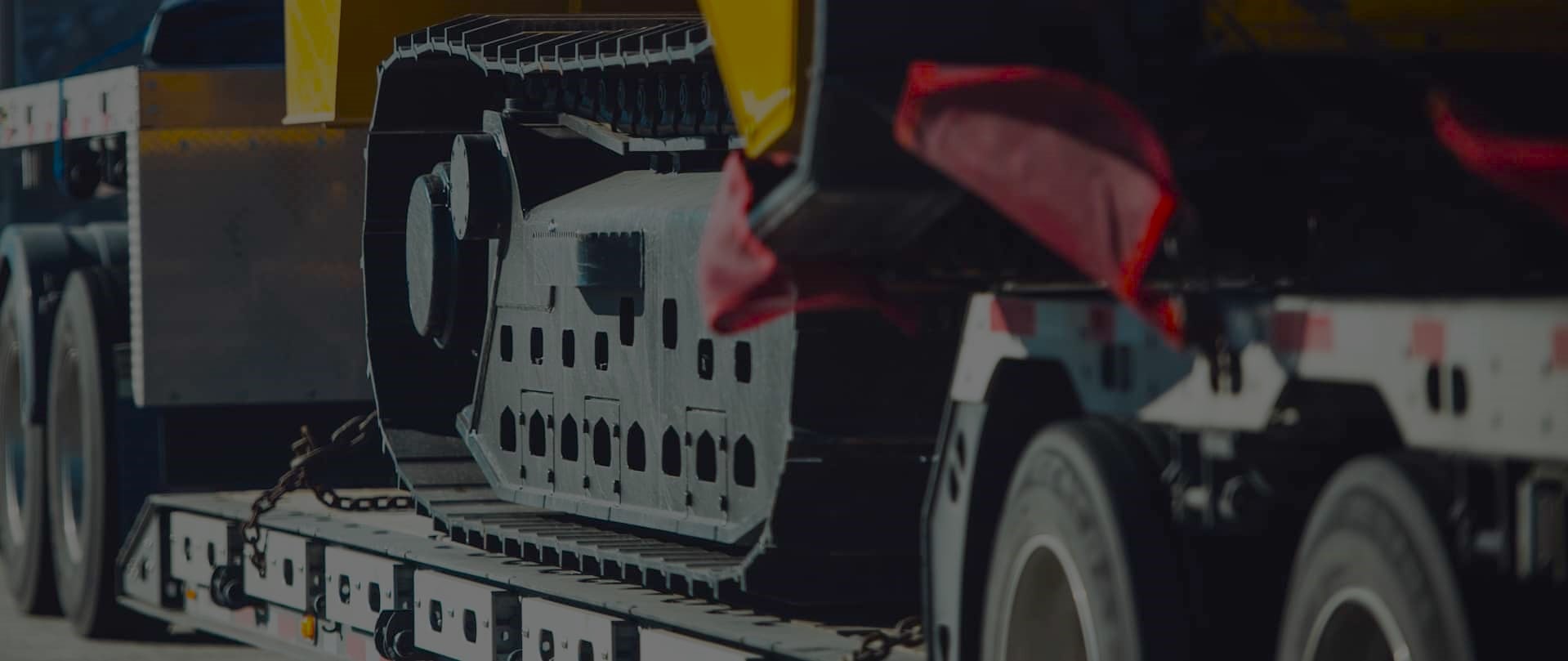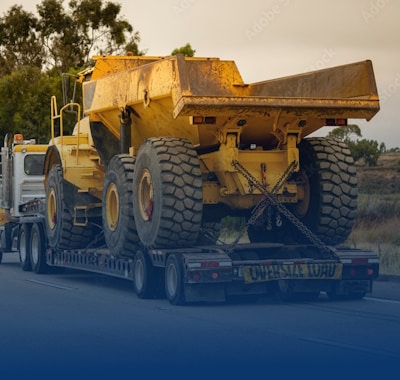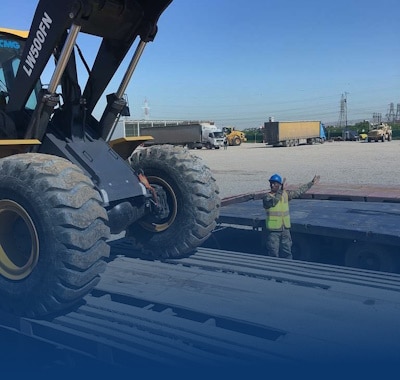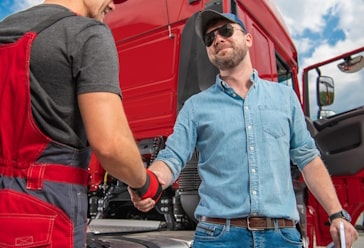Navigating Oversized Load Permits for Heavy Haul Rigs
Freedom Heavy Haul can offer expedited Pickup and Delivery for any size shipment anywhere in the USA. Contact us today for No Hassle, No Pressure Pricing.
Transporting heavy equipment needs careful planning, mainly for oversized loads. Getting the right heavy haul permits is key to keep your shipment safe and legal. Without them, you might face delays and fines that can mess up your project schedule.
First, you need to understand the state’s rules for oversized loads and how they apply to your rig. This guide covers the basics and offers practical tips. It helps you navigate the process smoothly, avoiding common problems and keeping your project on track.
Whether you’re moving construction gear or industrial parts, this article has you covered. It teaches you how to get permits quickly and plan safe routes.
Understanding Heavy Haul Permits: The Basics
Getting started with oversized load transport means learning the basics. Whether you’re new or need a refresher, these steps help you follow the law and run smoothly.
What Qualifies as an Oversized Load
An oversized load is bigger or heavier than usual. This usually means:
- Width over 8.5 feet
- Height over 13.5 feet
- Length over 80 feet
- Weight exceeding 80,000 pounds
Each state has its own rules. For example, Texas lets loads up to 14 feet tall with a permit. But California is stricter.
Types of Heavy Haul Permits Available
Permits vary based on the load and where you’re going. You might need:
- Single-trip permits: Good for one-time hauls, for a specific route.
- Annual permits: Best for those who haul often, for many trips.
- Multi-state permits: Needed when crossing state lines.
- Superload permits: For loads over 200,000 pounds.
When You Need to Apply for Permits
Apply for permits early. Most states want applications 48 hours to 30 days before. If you’re missing details, you might face delays.
“Always verify deadlines with state DOT offices. A late application risks fines or canceled hauls.” — FMCSA Guidelines
Remember to plan for route surveys, weather, and holidays. You’ll also need insurance and safety plans. Without these, your application might not get approved.
Essential Requirements Before Applying for Your Permit
Before obtaining transportation permits for large vehicles, make sure your rig is safe and legal. Check your vehicle’s tires, brakes, and suspension. Keeping them in good shape helps avoid breakdowns and follows regulations for transporting oversized freight.
Also, check your insurance. It should cover at least $1 million in liability, depending on where you are.
- Load Details: Give exact dimensions (height, width, length) and weight. Use certified scales for accuracy.
- Route Approval: Submit a planned route avoiding low bridges, narrow roads, or restricted zones. Apps like Rand McNally or Hammerhead help identify approved paths.
- Documentation: Prepare a bill of lading, vehicle registration, and driver’s CDL.
“State agencies prioritize safety. Incomplete applications delay approvals by weeks.” — U.S. Department of Transportation
| State | Escort Vehicles Required | Max Weight Allowed (lbs) |
|---|---|---|
| Texas | Over 12′ wide | 254,000 |
| California | Over 10′ wide | 150,000 |
Use tools like FMCSA’s Permit Routing to check state regulations for transporting oversized freight. For trips across states, look at agreements like the Western Regional Agreement to avoid extra paperwork. Missing a requirement can lead to fines up to $15,000, so check everything carefully before you submit.
Step-by-Step Guide to Navigating Heavy Haul Permits for Oversized Rigs
Getting the right permits for oversized loads is easier than you think. With a solid plan, you can handle it well. First, organize your papers, check your measurements, and plan routes that follow local laws. Here’s how to do it step by step.
Gathering Required Documentation
Start by gathering all the necessary documents. You’ll need your driver’s license, vehicle registration, insurance proof, and a detailed load description. Many states also ask for weight certifications or safety reports. Keep digital copies ready to make submissions faster.
Measuring and Recording Load Dimensions
Getting the measurements right is key. Use laser tools or certified scales to measure length, width, height, and weight. Even small mistakes can cause delays. For odd-shaped cargo, note any protrusions or uneven weight. Federal Motor Carrier Safety Administration (FMCSA) guidelines suggest taking photos or making diagrams of these details.
“Proper measurement ensures compliance and prevents costly fines. Always verify dimensions against state thresholds before submitting.”
Planning Your Route
Use tools like Rand McNally’s Motor Carrier Road Atlas to find restricted roads. Check for seasonal closures, construction, or height limits. Some states require escort vehicles or specific travel times for oversized loads. Plan these into your schedule.
- Use GPS software designed for commercial trucks, such as Trimble MAPS.
- Contact local DOT offices for real-time route updates.
- Confirm multi-state travel requirements if crossing borders.
State-Specific Permit Regulations to Consider
Understanding state-specific rules is key for successful heavy haul logistics. Each state has its own rules for oversized loads. This means you need a custom plan to avoid delays.
These rules affect everything from planning your route to when you travel. It’s important to do your research early.
Multi-State Permit Requirements
Traveling across state lines means you’ll need permits for each place. Texas, for example, requires special permits for loads wider than 14 feet. California needs extra escorts for loads taller than 15 feet.
The Federal Highway Administration’s permit database helps with applications. But, always check local rules too. Missing a permit can stop your whole project.
Regional Permit Agreements
Some states work together to make things easier. The Western Regional Permit Agreement covers 11 states for loads up to 16 feet wide. The Southern Regional Permit Program makes things simpler for the southeast.
See if your haul fits into these agreements:
- Western states: Arizona, Nevada, Utah, and others
- Southern states: Georgia, Florida, Alabama
“Regional agreements save time, but never assume blanket approval. Always confirm route details with state DOTs.” — U.S. Department of Transportation
Seasonal Restrictions
Winter snows or summer construction can change your plans. Minnesota bans oversized loads on icy roads. Colorado limits mountain passes from November to March.
Holiday weekends often mean tighter rules. Try to avoid these times to avoid delays. Rand McNally’s software helps keep you updated on road closures.
Knowing these rules helps keep your heavy haul logistics smooth. Work with state DOTs and regional agencies to plan better. This way, you can avoid surprises and stay efficient.
Common Challenges in the Permit Application Process
Getting permits can be tough. Issues like missing paperwork, route problems, and slow approvals are common. Even small mistakes can hold up your project, wasting time and money.
“Preparation is the backbone of successful permit applications. Double-check every detail before submitting.”
Some common problems include:
- Incomplete applications missing insurance or load details
- Route plans that don’t fit local rules or seasonal closures
- Payment issues that cause delays
In Minnesota, heavy haul trucks must follow strict rules on certain roads. A guide from Freedom Heavy Haul shows how planning routes ahead can prevent last-minute changes. Always check the rules for each state, if you’re traveling across them.
| Challenge | Impact | Solution |
|---|---|---|
| Missing Documentation | Application Rejection | Create a checklist for required files |
| Route Restrictions | Delays & Rerouting | Use GPS tools designed for oversized loads |
| Processing Delays | Missed Deadlines | Submit applications 2-3 weeks in advance |
Working with experienced permit services can help. They deal with complex paperwork, talk to agencies for you, and make sure you follow the rules. Always have digital copies of your permits ready during your trip.
Safety Requirements and Equipment Specifications
Transporting oversized loads requires strict safety rules. These rules help follow federal and state laws. They also protect drivers and the public. Here are important guidelines to follow.
Escort Vehicle Requirements
Escort vehicles guide and warn about oversized loads. Most states need at least one escort for loads over 12 feet wide or 100 feet long. Here are the rules for escorts:
- Use vehicles with high-visibility signage (e.g., “Wide Load” or “Oversized”).
- Equip escorts with two-way radios for real-time communication.
- Maintain a 500-foot buffer zone between the haul rig and other traffic.
“Pilot cars must display amber rotating lights and flags during daylight hours, per FMCSA regulations.”
Lighting and Marking Standards
Visibility is key. Heavy haul rigs need reflective tape, LED lights, and oversized banners. Here are the standards:
- Red or orange flags on load edges extending beyond 4 inches.
- Strobe lights or rotating beacons visible from 500 feet.
- Reflective chevrons on the rear of trailers (3M Diamond Grade™ tape recommended).
Required Safety Equipment
Every heavy haul rig must carry tools for emergencies. Inspectors check for:
- Fire extinguishers (ABC-rated, mounted near the cab).
- Spare tire kits rated for the load’s weight.
- Warning devices like flares or reflective triangles (JBC Safety Lights preferred).
Regularly check if your equipment meets DOT standards. Trained drivers and the right equipment make the road safer for everyone.
Understanding Permit Costs and Processing Times
Managing heavy haul permit costs involves balancing several factors. These include state fees, route complexity, and load specifications. Most states charge between $10 and $1,000 per permit. Prices can go up for multi-axle rigs or routes through urban areas.
For example, Texas charges $80–$500 for standard permits. California adds toll-based fees for bridges. Variables like escort vehicles or seasonal road restrictions can also increase costs.
| State | Base Permit Fee | Processing Time |
|---|---|---|
| Texas | $80–$500 | 1–3 business days |
| California | $120–$800 | 3–7 business days |
| Florida | $60–$300 | 1–2 business days |
Permit processing times vary by state. Fast-track options are available in some states, like Arizona, for a 25%–50% extra fee. Delays can happen due to incomplete applications or route conflicts.
To avoid delays:
- Submit applications at least 10 days before departure
- Verify load dimensions match registered specifications
- Confirm route clearance with local DOT offices
“A single missing signature can add weeks to permit approval. Double-check every form.” – DOT Compliance Officer
Tools like DAT Permit Service or uDrove Permit Manager help track expenses and deadlines. These platforms provide real-time updates on permit processing times. This reduces the need for manual follow-ups. Always budget 15%–20% extra for unexpected fees, such as last-minute route changes or weather-related delays.
Partnering with experienced permit brokers can lower costs. They offer volume discounts and pre-negotiated state rates. They also streamline paperwork and navigate multi-jurisdiction requirements. This ensures your project stays on schedule and within budget.
Technology Tools for Permit Management
Managing permits for oversized loads is easier now. Modern tools make the process simpler, cut down on delays, and ensure you follow the rules. They offer automated applications and real-time tracking, making every step smooth and on time.
Digital Permit Systems
Digital permit systems get rid of paper and mistakes. Sites like Permits.com or DAT Permit Service let you apply online, track approvals, and keep documents safe. They connect with state databases, making sure you meet all the rules. Instant updates help you avoid mistakes, so you can focus on driving.
Route Planning Software
Route planning software for oversized loads considers height, weight, and traffic. Tools like Trimble MAPS or Axon Truck Routing create the best routes, avoiding dangerous areas. For tips on balancing speed with safety, check out expert route analysis. These tools also have backup plans for road closures.
Mobile Apps for Permit Tracking
Mobile apps like Trucker Path or MyPilot keep your permits handy. They send alerts for checkpoints, let you share documents with escorts, and track your journey. GPS updates help adjust your route if there’s bad weather or traffic.
| Tool | Category | Key Features |
|---|---|---|
| Permits.com | Digital Permit System | Multi-state applications, instant approvals |
| Trimble MAPS | Route Planning Software | Low-clearance alerts, weight restrictions |
| Trucker Path | Mobile App | Permit tracking, real-time updates |
Using these tools together makes managing permits smooth. Start with digital systems for approvals, then plan your route with software, and track it with apps. This way, you’ll have fewer delays, save money, and have smoother hauls.
Important Time Restrictions and Travel Limitations
When moving oversized loads, timing is everything. You must follow strict time limits and travel rules for heavy haul rigs. Missing deadlines or hitting roadblocks can cause big delays. Planning ahead helps keep your cargo moving smoothly.
Holiday Travel Restrictions
Many states limit or ban oversized loads during holidays. For instance:
- Texas restricts hauling on Memorial Day and Labor Day weekends.
- California has curfews for heavy rigs near big cities during Thanksgiving.
- Florida limits travel on Interstate 95 during New Year’s Eve.
Always check state DOT websites for holiday schedules. Permits often have specific travel times to avoid traffic.
Weather-Related Considerations
Severe weather can be a big risk for heavy haul rigs. Snowstorms in the Midwest, hurricanes along the Gulf Coast, or wildfires in the West can force route changes. Use tools like NOAA Weather Radio or state apps to track weather. Adjust your departure times if bad weather is forecasted.
“Customized route planning isn’t just about distance—it’s about adapting to real-time conditions. Partnering with experts like Freedom Heavy Haul ensures you avoid seasonal bottlenecks and stay compliant.”
Plan for extra days for long trips. States like Colorado and Montana close mountain passes in winter. Coastal areas may ban travel during hurricanes. By planning with time restrictions and travel rules in mind, you avoid delays and meet your delivery deadlines.
Insurance and Liability Considerations
Carrying oversized loads is more than just getting permits and planning routes. It’s about protecting against unexpected risks. Insurance for oversized loads often goes beyond what regular commercial policies offer. Without the right coverage, accidents or damage to cargo can cause big financial losses, legal issues, or delays.
Typical insurance policies include:
- Cargo insurance: Covers damage to the load during transit.
- General liability: Protects against third-party injury or property damage claims.
- On-hook coverage: Safeguards rigs and equipment during loading/unloading.
Liability for heavy haul rigs also means knowing state laws. For example, Texas needs a minimum of $500,000 in liability coverage for oversized loads. California requires $1 million for certain routes. Ignoring these rules can lead to fines or losing your permit.
“Always consult a transportation attorney to review contracts and ensure compliance with federal and state liability laws.” – American Transportation Research Institute
| Provider | Coverage Type | Key Benefit |
|---|---|---|
| Progressive | Oversized Load Specialty | Multi-state policy flexibility |
| Liberty Mutual | Heavy Haul Liability | 24/7 claims support |
| Zurich North America | Cargo & Equipment | Customizable deductibles |
Check your policy every year and update it if needed. Working with insurers like Great West Casualty or Sentry Insurance can help. Stay ahead by planning well today to avoid problems later.
Your Path Forward: Maximizing Permit Efficiency for Future Hauls
Start by applying what you’ve learned to maximize permit efficiency. Use tools like PermitMaster or DAT Permit Service to automate applications and cut down on errors. Partnering with logistics experts like Axon Routes ensures you follow the right routes and saves time.
These steps make planning for oversized loads in the future more predictable and cost-effective. It helps keep your hauls on track.
Stay ahead by adopting digital tools. Use GPS-powered route planners from Rand McNally or HammerTech to avoid low bridges and seasonal restrictions. Mobile apps like MyPermitPAL track applications in real time. Regular training on FMCSA updates keeps your team up to date on changing state rules.
This proactive approach helps avoid delays and fines. It keeps your operations smooth.
Review past hauls to spot patterns. Did holiday traffic in Texas or winter closures in Colorado slow deliveries? Use historical data to adjust schedules. Insure loads through providers like Progressive Commercial or Liberty Mutual to cover unexpected risks.
By refining strategies each trip, you create a smoother process for every oversized load moving forward.







